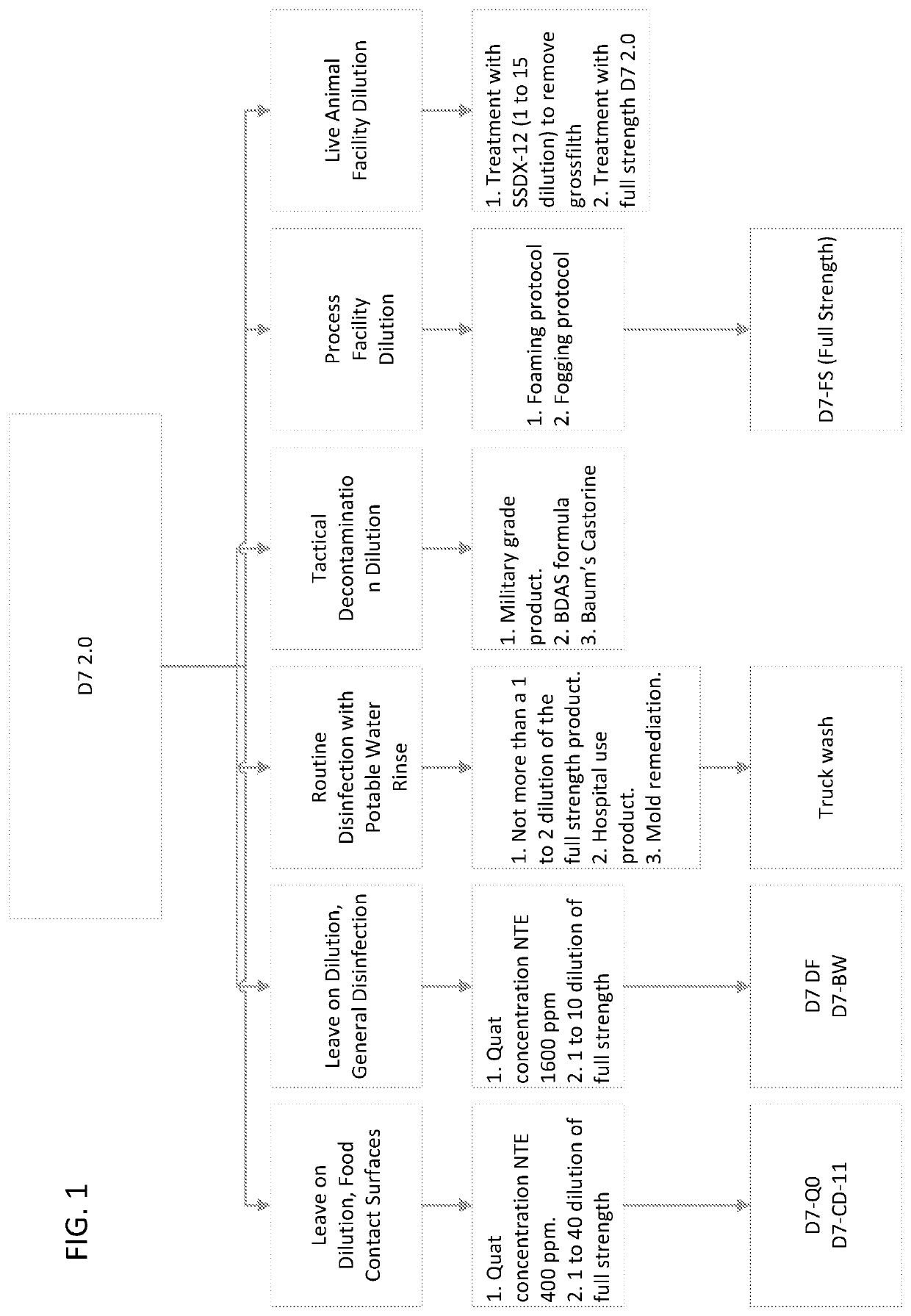Surface and laundry decontamination formulation
a decontamination formulation and laundry technology, applied in the field of formulations, can solve the problems of difficult dislocation, insufficient physiochemical environment of remediating now dissolved water or other solvents, and insufficient remediation of now dissolved water, etc., and achieve the effect of improving ability
- Summary
- Abstract
- Description
- Claims
- Application Information
AI Technical Summary
Benefits of technology
Problems solved by technology
Method used
Image
Examples
example 1
Experiment 1
[0054]Modification of interfacial tension characteristics of the D7 2.0 may be the essence of the invention. As provided above, interfacial tension is the force that must be overcome between the barrier separating two immiscible phases. The principles underlying this behavioral property are well documented. In one embodiment, the lower the interfacial tension, the more vulnerable the interface is to the penetration of water and the reactive activated oxygen species germane to the formulation. As an example, in experiment 1, a drop of beef grease in contact with water will not be dissolved and will remain intact indefinitely for all intent and purposes. The interfacial tension between beef grease and water may be about 20 to 30 millinewton / meter (mN / m). The x-axis represents time after grease drop formation in minutes.
[0055]In this experiment, the beef grease proxy was then exposed to the D7 predicate 102 and D7 2.0 variant 104, where the D7 predicate 102 may not include ...
example 2
Experiment 2
[0056]Surface chemistry modification measurement may be achieved by employing a proprietary surface chemistry Pendant drop analysis method that may measure the volume and shape of a defined droplet versus time reckoned from initial exposure to the test formulation. This measurement may utilize a sophisticated imaging technique that continuously calculates the pendant drop volume and shape. The time to achieve 50% of the initial drop volume is one of the performance figures of merit which was noted and compared to different formulation variants. A typical plot result is shown in FIG. 3.
[0057]In one embodiment, the shift of the curve to the left upon exposure to the D7 2.0 variant may indicate a more rapid cleaning action. The t1 / 2 volume time was 157 minutes at 206 for the D7 2.0 variant compared to 185 minutes at 208 for the D7 predicate. This represents a 15% improvement in decontamination performance relative to the predicate.
[0058]In one embodiment, this interfacial t...
example 3
SSDX at 15:1
[0069]SSDX-12 is designed to achieve a safe, environmentally benign, low regret physiochemical agency capable of enabling conditions favorable toward the removal or deshielding of pathogens / agents / contaminant / toxins. With the application of SSDX-12, the offending substance can be hydraulically removed or rendered hydraulically vulnerable.
[0070]In one example, the SSDX-12 may include a cleaning composition such as a C.sub.8-22 alkyl dimethylamine oxide surfactant, a C.sub.6-12 alkyl dimethylamine oxide surfactant, a C.sub.8-18 alkyl polyethylene glycol sorbitan fatty ester surfactant, and a C.sub.12-14 secondary alcohol ethoxylate surfactant. The C.sub.8-18 alkyl polyethylene glycol sorbitan fatty ester surfactant includes from 0 to about 20 ethoxylate groups per C.sub.8-18 alkyl polyethylene glycol sorbitan fatty ester surfactant molecule. The C.sub.12-14 secondary alcohol ethoxylate surfactant includes from about 14 to about 16 ethoxylate groups per C.sub.12-14 secondar...
PUM
 Login to View More
Login to View More Abstract
Description
Claims
Application Information
 Login to View More
Login to View More - R&D
- Intellectual Property
- Life Sciences
- Materials
- Tech Scout
- Unparalleled Data Quality
- Higher Quality Content
- 60% Fewer Hallucinations
Browse by: Latest US Patents, China's latest patents, Technical Efficacy Thesaurus, Application Domain, Technology Topic, Popular Technical Reports.
© 2025 PatSnap. All rights reserved.Legal|Privacy policy|Modern Slavery Act Transparency Statement|Sitemap|About US| Contact US: help@patsnap.com



